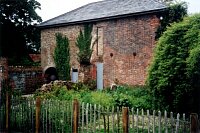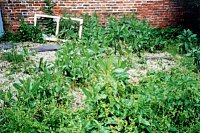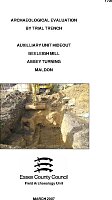| Name: | British Resistance "Hideout", Beeleigh Falls House, Maldon |
|---|
| SMR Number: | 20277 |
|---|
| Type of record: | Monument |
|---|
| Grid Reference: | TL 839 081 |
|---|
| Map Sheet: | TL80NW |
|---|
| Parish: | MALDON, MALDON, ESSEX |
|---|
Summary
Underground Command Post. The Old Mill, Beeleigh Falls House, Maldon.
Full description
1999: Contemporary records state, "Underground Command Post. The Old Mill, Beeleigh Falls House, Maldon". and "U/G Chamber. House and Garden. Beeleigh Falls". <1>
Enquiries of the current owner of Beeleigh Falls House reveal that there was indeed an underground chamber built in the garden of the old mill. It was discovered by the present owner and Water Board officials whilst work was going on some 15 years ago, and was sited in the garden, beneath overgrown roses, backing on to the mill wall. Apparently, steps - it is not recalled whether wooden or concrete - led down to a curved-roof chamber, perhaps 10 feet long, built of Anderson shelter sheets. When the owner returned later the same day the entire site had been levelled, and remains so to this day, although it is not known to what extent the chamber was demolished. <2>
It cannot be positively said what this "Underground Command Post" may have been. " Warmen Courageous - the Story of the Essex Home Guard", written in 1951, is extra-ordinarily detailed about the Maldon area but makes no mention of this site in its Home Guard or Civil Defence listing. <3>
On balance, it appears likely that this was one of the British Resistance hideouts constructed in out-of-the-way places to provide an operational base for a small section of 6/7 " Auxiliary Unit" personnel. Of many designs, some are known to have been built of Anderson shelter sheets. "The Last Ditch", written in 1968, indicates that at least 27 or 28 of these bases were constructed in Essex although no precise locations are given. <4>
Three photos of site. <5>
In 2006, it was reported that one of the wartime members of the ‘Auxiliary Unit’ which was based at Beeleigh Mill had visited the site within the past year <6>. He confirmed the existence of the ‘hideout’ (officially known as an ‘Operational Base’). The entrance was below ground level from within the mill, through the mill wall. The living chamber was where previously indicated, beneath the former rose garden. An escape tunnel led from high up on the end wall of the chamber to an underground water course some yards away, part of the original mill architecture. The water course is brick-lined and the tunnel came out through the upper part of the arched brickwork. A canoe was moored here.
February 2007: On successive Mondays in February 2007 part of the site was excavated by ECC Field Archaeology Unit with the aid of a small mechanical digger. Excavation concentrated where there was a clear depression in the ground some 18 feet from the wall of the mill, 22 feet from the SE wall of the enclosure. Beneath a few inches of top soil the ground was found to be pure sand. Approx. 3 feet below the surface the top of the end wall of the chamber was discovered, built of hollow cement blocks. Four feet below the surface, abutting the end wall on the mill side, the upstanding ends of curved Anderson shelter sheeting came into view, clearly part of the side sheeting. Outside the end wall, rotten corrugated iron sheeting (not Anderson) and wooden beams were revealed and, eventually, what could be the top of a concrete escape tunnel. It appears likely that this tunnel was constructed by digging a deep trench between the chamber and the water course. This was shored up with corrugated iron braced by the wooden beams. At the bottom of the trench the concrete escape tunnel was formed and the trench was then filled in on top of the tunnel.
Perhaps 2 feet of the top of the end wall (partly demolished it is thought) was revealed; the sand within the chamber was dug out to approx. one foot below the top of the upstanding Anderson shelter sheets; and the escape tunnel trench was excavated to approx. 3 feet below ground level. Within the chamber, excavations were not dug down to reveal the entrance to the escape tunnel. All excavation was well away from the mill, in a T-shape 6’/7’ across, each side of the end wall of the chamber. The site was recorded by the F.A.U. and the excavation in-filled at the end of the second day.
It is reported that after the war these British Resistance hideouts were systematically demolished by teams of Royal Engineers <7>. This is clearly what happened here. The centre part of the roof sheeting was unbolted, probably along its length, and the entire structure was then filled with sand, the centre sheets being thrown in. It is probable that the reported ‘steps’ were wooden (possibly up to the escape hatch), being thrown in with the roof sheets.
See report by ECC Field Archaeology Unit <8>. 27 photos taken of site <9>.
SITE ASSESSMENT FEBRUARY 2007: Although the extent of survival of this hideout cannot be determined at this stage, it appears likely that it has survived in almost its entirety since the end of the Second World War, with possibly only the central roof sheets to be replaced or re-bolted on to return the structure to its wartime form. Nationally, very few of these British Resistance hideouts have survived and this example has the potential to be among the best of these.
March 2007: A subsequent communication via the nephew of the former resistance member and Michael Hoyle, the millwright, details further features of the hideout. The escape tunnel was c. 2’6” square with its entrance near to the top of the bunker. It was lined in corrugated steel with small shelves for storage and came out near the crown of the brick water tunnel – the tailrace. The boat was 10’ long and could carry all six of the group. As the headrace was still in existence the water rushed through the tailrace. The boat with its occupants would thus be carried quickly through the tailrace.
The entrance to the bunker was from inside the mill ‘the 3rd flagstone from the far wall (on RHS looking in)’. The galvanised shaft was c. 8’ deep with a ladder. At the bottom was an arch (through foundations?) about 3 feet tall ‘which led straight into the room – about 8 ft by 10 ft’. The room itself was lined with corrugated steel. ‘There were shelves in the entrance lobby as you walked through. Explosives were kept there with timers and cables and also hand grenades. Their armament was a Smith and Wesson 9 mm pistol and commando knife. No rifles.’ They were trained as explosive experts, creeping in and out of British Army depots to lay dummy charges. ‘The group met in Mr. Markham’s house opposite the hospital in Maldon.’
The hideout was filled in within 6 months of the end of the war <10>.
Essex Archaeology and History, 2008, Essex Archaeology and History volume 39 (DESC TEXT). SEX73069.
<1> unknown, 1968, War Time Contraventions 1968, Maldon (LIST). SEX31436.
<2> owner, 1999, Pers comm owner, Beeleigh Falls House (Verbal communication). SEX62463.
<3> Finch, P, 1951, Warmen Courageous; The Story of the Essex Home Guard, appendix E p.322 (DESC TEXT). SEX59666.
<4> Lampe, D, 1968, The Last Ditch (DESC TEXT). SEX62465.
<5> Nash, Fred, 1999, British Resistance "Hideout", Beeleigh Falls House, Maldon (Photograph). SEX62466.
<6> Hoyle, M, 2006, Personal Communication (Verbal communication). SEX66747.
<7> Lampe, D, 1968, The Last Ditch, p.102 (DESC TEXT). SEX62465.
<8> Ennis, T, 2007, Underground Command Post, Beeleigh - Excavation Report - Forthcoming (DESC TEXT). SEX66748.
<9> Nash, Fred, 2007, Excavation of B. R. Hideout, Beeleigh Mill, 27 frames (Photograph). SEX66749.
<10> Hoyle, M, 2007, notes of telephone conversation with nephew of resistance member, Feb 2007 (Verbal communication). SEX66750.
Monument Types
- AUXILIARY HIDE (WWII, Modern - 1939 AD to 1945 AD)
Associated Events
- Maldon Survey WWII by Fred Nash (Ref: Nash MAL Jan-Dec 1999)
- B. R. Hideout at Beeleigh Mill (Ref: ?)
Protected Status
- Conservation Area: Chelmer and Blackwater Navigation (MALDON)
Sources and further reading
| --- | DESC TEXT: Essex Archaeology and History. 2008. Essex Archaeology and History volume 39. |
| <1> | LIST: unknown. 1968. War Time Contraventions 1968. Maldon. |
| <2> | Verbal communication: owner. 1999. Pers comm owner, Beeleigh Falls House. |
| <3> | DESC TEXT: Finch, P. 1951. Warmen Courageous; The Story of the Essex Home Guard. appendix E p.322. |
| <4> | DESC TEXT: Lampe, D. 1968. The Last Ditch. |
| <5> | Photograph: Nash, Fred. 1999. British Resistance "Hideout", Beeleigh Falls House, Maldon. |
| <6> | Verbal communication: Hoyle, M. 2006. Personal Communication. |
| <7> | DESC TEXT: Lampe, D. 1968. The Last Ditch. p.102. |
| <8> | DESC TEXT: Ennis, T. 2007. Underground Command Post, Beeleigh - Excavation Report - Forthcoming. |
| <9> | Photograph: Nash, Fred. 2007. Excavation of B. R. Hideout, Beeleigh Mill. print. 27 frames. |
| <10> | Verbal communication: Hoyle, M. 2007. notes of telephone conversation with nephew of resistance member. Feb 2007. |
Images
 British Resistance Hideout © Essex County Council |  British Resistance Hideout © Essex County Council |
 British Resistance Hideout © Essex County Council |  No image description available © Essex County Council |
Search results generated by the HBSMR Gateway from exeGesIS SDM Ltd.